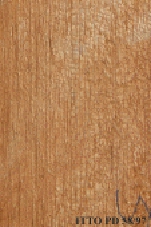
COPAIBA (Copaifera pubiflora)
Trade Name
Copaiba
Scientific Name
Copaifera pubiflora Benth.
Family
LEGUMINOSAE
Common Names
Balsamo (Trinidad & Tobago); Bálsamo De Copaiba (Cuba); Aceite (Venezuela); Copaiba (Peru); Cupay (Paraguay); Canime (Colombia); Aceite Copaiba (Colombia); Caniva (Panama); Palo De Aceite; Cupaiba (Colombia); Aceite Copaiba (Venezuela); Aceite Cabimo (Venezuela); Copaíba (Brazil)
Scientific Name Synonyms
Copaifera martii var. publiflora (Benth.) Benth.
Description Of The Tree
Botanical Description
The trees are reported to reach heights of up to 40 m, with trunk diameters of 100 cm. The boles are cylindrical, with commercial lengths of about 30 m.
Natural Habitat
Copaifera pubiflora is found in tropical rain and dry forests. It prefers lowland well drained sites.
Natural Distribution
It is reported to occur in Venezuela and Colombia.
Wood Identification
Anatomic Description Of Wood
Wood diffuse porous. Occasionally vessels in dendritic pattern. Vessels solitary and in short radial multiples. Tangential diameter of vessel lumina 150 to 200 micras (medium). Red-colored deposits in heartwood vessels. Vestured pits. Vessels per mm2 less than Axial parenchyma in marginal or in seemingly marginal bands. Paratracheal axial parenchyma thin vasicentric. Axial parenchyma aliform. Prismatic crystals in chambered axial parenchyma cells and/or in fibers. 4 to 10 rays per mm (medium). Rays 1 to 4 seriate. Body ray cells procumbent with one row of upright and/or square marginal cells (Kribs-III). Occasionally septate fibers present. Fibers with simple to minutely bordered pits.
-
 Wood Macro Photo Radial Plane
Wood Macro Photo Radial Plane
Availability
Cites Status
Unrestricted
General Wood Description
Odor
Typical, oily. It has a bitter taste
Color
The sapwood is pinkish white, the heartwood is reddish yellow.
COLOR INDEX (1=Black, 7=Light yellow,white)
5
Grain
The grain is reported to be straight or interlocked.
Texture
This species is usually reported to have a medium texture.
Luster
The wood is described as moderate in luster.
Natural Durability
Copaiba timber is reported as moderately durable against decay and insects attack.
Natural durability index (1= Very high durability, 7=Vey low durability)
3
Resistance To Impregnation
The timber is difficult to treat with preservatives.
Wood Physical Properties
Basic Density or Specific Gravity (O.D. weight/vol. green) (g/cm³)
0.48
Air-dry Density (Weight and volume at 12%MC) (g/cm³)
0.53
Total shrinkage Tangential (Saturated to 0%MC) (%)
6.6
Total shrinkage Radial (Saturated to 0%MC) (%)
3.4
Drying Defects
Ease of Drying: Air season is reported to be fairly rapid. Drying Defects: Risk of twisting and checking is reported. Kiln Schedules: Air seasoning is recommended before kiln drying.
Recommended Dry Kiln Schedule
JUNAC-A
Dimensional stability ratio (Total Tangential Shrinkage %/Total Radial Shrinkage %)
2.0
Wood Chemical Properties
Wood Mechanical Properties
Bending Strength (MOR),12%MC (kgf/cm²)
690
Stiffness (MOE) 12%MC (kgf/cm²)
77444
Compression parallel to fiber 12%MC (kgf/cm²)
390
Workability
Sawing
Sawing of this species is easy.
Rotary Veneer Cutting
Light Copaifera species are reported to be interesting for peeling, the heavier species can be sliced.
Sliced Veneer
Light Copaifera species are reported to be interesting for peeling, the heavier species can be sliced.
Blunting Effect
It has a slight blunting effect on the cutting tools.
Machining
It is easy to machine.
Turning
30
Gluing
Trees of the Copaiba group are reported to have a high oil-resin content which can render gluing problems depending on the adhesive used.
Finishing
Copaifera is reported to yield a smooth finishing.
REFERENCED USES
End Uses Summary
HOUSING GENERAL, beams, joists, boards, fittings, shutter boards, FURNITURE AND CABINETS, PLYWOOD AND VENEER, TURNING, PACKING, heavy packing, OTHER AND MUSICAL INSTRUMENTS, door core, moldings, particleboard, cementboard
General Housing
- 10 - Silica in Timbers
Beams
- 11 - Prospect: The wood database
Joists
- 12 - Tropical timbers of the world. Part I-Tropical American Species
Boards
- 13 - Dry kiln schedules for commercial woods. Temperate and tropical. Section III. Latin American (Mexico, Central, and South America) Woods–Conventional Temperatures
Fittings
- 19 - Silica in Timbers
Shutter Boards
- 20 - Prospect: The wood database
Furniture Cabinets
- 21 - Tropical timbers of the world. Part III-Southeast Asian and Oceanian Species.
Panels, Veneers
- 25 - Directory of Timber Trade Malaysia
Turning
- 30 - Embassy of Honduras in Japan
Packing
- 45 - Recopilación y Análisis de Estudios Tecnológicos de Maderas Peruanas
Heavy Packing
- 47 - Arvores Brasileiras
Door Cores
- 76 - Descripción General y Anatómica de 105 Maderas del Grupo Andino.
Molding
- 79 - Padronização da Nomenclatura Comercial Brasileira das Madeiras Tropicais Amazônicas, Sugestão
Particleboard
- 80 - Estudio Integral de la Madera para Construcción
Cementboard
- 81 - Madeiras da Amazônia: descrição do lenho de 40 espécies ocorrentes na Floresta Nacional do Tapajós
Please Provide Information To View Producer Information